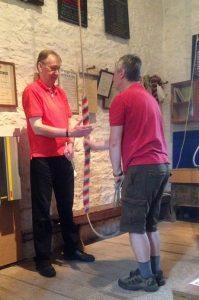In September 2015, there had been no local band to ring Kirtlington’s very fine peal of eight bells for 10 years, after the previous tower captain and his wife moved away to Derbyshire.
After efforts by villagers to raise interest, Ron Burgess and Willie Haynes with other local regular ringers started Monday evening bellringing practices, with 15 recruits attending the first sessions in late September 2015.
As so often with such initiatives, several recruits dropped out through injury, illness or pressure of work or family life. However, a core of five or six remained. Two, myself included, got the bellringing “bug” and started ringing two or more nights a week, joined the Bicester branch of bellringers and went on the Radley ringing course in April 2016.
When Ron was unable to commit to leading all the practices it occurred to me that unless our new team members gained the skills and confidence to be able to teach handling to others, that ringing at Kirtlington could not continue for much longer.
I had only learned to ring for a year or so as a teenager some 40 years before, and felt very unqualified to lead practices or train novices. I therefore badly needed the help of an organisation that could provide a structured programme of teaching, based on consultation with professionals in sports and music coaching and psychological development, along with a system of accreditation and mentoring. The Association of Ringing Teachers, or ART, is that organisation, and I was most fortunate to be able to attend the Module 1 course at Abingdon in June 2016, and even more fortunate that Ron Burgess was willing and able to accompany me and be my mentor.
I was most impressed with the scheme that ART has devised through its “Learning the Ropes” scheme for learners, which takes the absolute beginner through five progressive stages up to ringing quarter peals in Plain Bob Minor and other minor methods. The set of tools and resources they provide for teachers through the “SmART Ringer” scheme is considerable and growing and certainly gave me the confidence to start working with novices and more experienced ringers to teach and improve handling.
I started by teaching my son to ring in July (amazing how young people learn so rapidly!) before his change of career made him stop (hopefully only a temporary pause). Then in November 2016, I was contacted by someone whose family had Kirtlington connections and wanted to learn to ring. As a very quick learner, she was ringing rounds and call changes proficiently by Christmas 2016, was inspired to go on the Radley ringing course last April and has enrolled on a residential ringing course this summer. I am now teaching another, older learner, who is also making excellent progress.
The ART teaching scheme requires new teachers to be accredited within 2 years of attending the course. With the support of Ron and Alison Merryweather-Clarke, I have recently passed an assessed teaching lesson and am now accredited in Module 1. I have also enrolled on a course in June for the next module: 2F, which covers teaching from Rounds to Plain Hunt. A further module, 2C, covers the teaching of methods to minor.
So that is my story. A lapsed ringer with a bit of basic handling experience from their youth, started again in later life and, as so often with bellringing, has had to take on a teaching role (not to mention understanding of bell maintenance, recruitment, public relations and more) to help keep this unique and rewarding skill and pastime alive, and am very grateful for the support that ART and local experienced ringers have given me. Over the past 18 months I have hugely enjoyed the teamwork, satisfaction of learning, working with and helping others as well as gaining a whole new community of friends connected with bellringing./
If you are interested in ART, check out the website: http://ringingteachers.org/ or give me a ring on 07710-487223.
Steve Vickars

